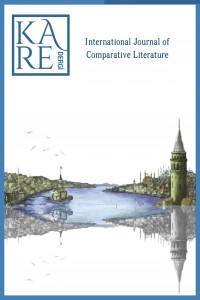Poetic Alterity as an Element Triggering Interculturality in the Context of Yoko Tawada's Work Talisman
Poetic Alterity as an Element Triggering Interculturality in the Context of Yoko Tawada's Work Talisman
___
- Altmayer, C. (2004). Kultur als Hypertext. Zu Theorie und Praxis der Kulturwissenschaft im Fach Deutsch als Fremdsprache. München: Iudicum.
- Bredella, L. (2010): Das Verstehen des Anderen: Kulturwissenschaftliche und literaturdidaktische Studien (Giessener Beiträge zur Fremdsprachendidaktik). Tübingen: Günter Narr Verlag.
- Esselborn, K. (2007): Interkulturelle Literatur – Entwicklungen und Tendenzen. In: Honnef-Becker, Irmgard (Hg.). Dialoge zwischen den Kulturen. Interkulturelle Literatur und ihre Didaktik. Baltmannsweiler: Schneider Hohengehren.
- Hofmann, M. (2006). Interkulturelle Literaturwissenschaft. Eine Einführung. Paderborn: W. Fink Verlag.
- Inglehart, R./Welzel, C. (2005): Modernization, Cultural Change and Democracy. New Jersey, Princeton University Press Leskovec, A. (2009). Fremdheit und Literatur. Alternativer hermeneutischer Ansatz für eine interkulturell ausgerichtete Literaturwissenschaft. Berlin: LIT Verlag.
- Mecklenburg, N. (2009). Das Mädchen aus der Fremde: Germanistik als interkulturelle Literaturwissenschaft. München: Iudicium.
- Müller-Jacquier, B. (2004): ‚Cross-cultural’ versus interkulturelle Kommunikation. Methodische Probleme der Beschreibung von Inter-Aktion. In: Lüsebrink, H.-J. (Hg.): Konzepte der Interkulturellen Kommunikation: Theorieansätze und Praxisbezüge in interdisziplinärer Perspektive. St. Ingbert, Röhrig.
- Tawada, Y. (1996). Talisman. Tübingen: Konkursbuchverlag.
- ISSN: 2536-4596
- Yayın Aralığı: Yılda 2 Sayı
- Başlangıç: 2016
- Yayıncı: Hasan BAKTIR
Öteki’ni Öldürmek Ekseninde “Andorra” ve “To Kill A Mockingbird”
Türk ve Rus Mitolojisinde Hayvan Mitleri
D.H. Lawrence’ın Âşık Kadınlar ve Toni Morrison’ın Sula Adlı Eserlerinde Toplumsal Yaşamda Kadın
Çeviri Üzerinden Kültürlerarasılığı Okumak
İlyas ÖZTÜRK, Fatıma GİMATDİNOVA
Romantizmle İlişkileri Bağlamında Goethe’nin Werther’i ve Austen’ın Marianne’i
Türkiye'de Bir Siegfried Efsanesi
